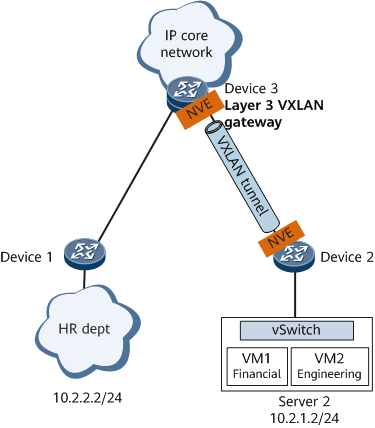Application for Communication Between Terminal Users on a VXLAN and Legacy Network
Service Description
Currently, data centers are expanding on a large scale for enterprises and carriers, with increasing deployment of virtualization and cloud computing. In addition, to accommodate more services while reducing maintenance costs, data centers are employing large Layer 2 and virtualization technologies.
As server virtualization is implemented in the physical network infrastructure for data centers, VXLAN, an NVO3 technology, has adapted to the trend by providing virtualization solutions for data centers, allowing intra-VXLAN communication and communication between VXLANs and legacy networks.
Networking Description
On the network shown in Figure 1, an enterprise has VMs deployed for the finance and engineering departments and a legacy network for the human resource department. The finance and engineering departments need to communicate with the human resource department.
Feature Deployment
As shown in Figure 1:
Deploy Device 2 as Layer 2 VXLAN gateway and Device 3 as a Layer 3 VXLAN gateway. The VXLAN gateways are VXLANs' edge devices connecting to legacy networks and are responsible for VXLAN encapsulation and decapsulation. Establish a VXLAN tunnel between Device 2 and Device 3 for VXLAN packet transmission.
- Device 1 receives the packet and sends it to Device 3 through IP network.
- Upon receipt, Device 3 parses the destination IP address, and searches the routing table for a next hop address. Then, Device 3 searches the ARP or ND table based on the next hop address to determine the destination MAC address, VXLAN tunnel's outbound interface, and VNI.
- Device 3 encapsulates the VXLAN tunnel's outbound interface and VNI into the packet and sends the VXLAN packet to Device 2.
- Upon receipt, Device 2 decapsulates the VXLAN packet, finds the outbound interface based on the destination MAC address, and forwards the packet to VM1.
